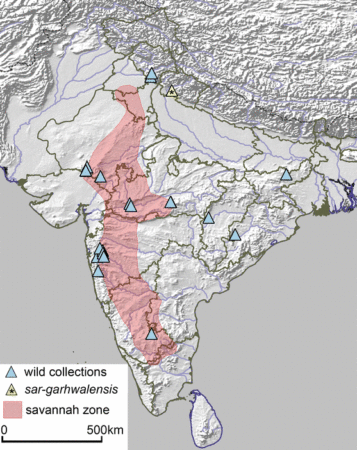The indefatigable Dorian Fuller has been even less fatigable than usual lately, with a couple of papers in the past few weeks on the history of the horsegram, Macrotyloma uniflorum. The first is a general review of the geographical, linguistic and archaeological evidence for the origins of the crop. They point to a long history in India and at least two separate domestications there.

The second is a much deeper dive into the history of domestication, using high resolution x-ray computed tomography with a synchrotron to measure non-destructively the decrease in seed coat thickness with time in archaeological remains of domesticated material. A thin seed coat is thought to be related to loss of dormancy, and hence part of the domestication syndrome. It had been suggested that rare non-dormant variants might have been selected during domestication, but the evidence from horsegram is that even the thick-coated, and therefore presumably still dormant, material was domesticated.
Which is all very interesting, but what I want to leave you with is a little quiz. Given that Kersting’s groundnut is now also in Macrotyloma, as M. geocarpum (Harms) Maréchal & Baudet, how many other con-generic species can you think of that were domesticated on separate continents? Apart from the two Oryza species, of course.
Cotton.
Solanums!
and Vignas
Dioscorea yams
Amaranth!
Many multi-continent millets!
Digitaria cricuiata (domesticated around Assam); Digitaria exilis and Digitaria iburua (west Africa)
Brachiaria ramosa (India); Brachiaria deflexa (West Africa)
Panicum miliaceum (China); Panicum sumatrense (India); Panicum sonorum (American Southwest)
Setaria italica (China); Setaria pumila and Setaria verticilata (India); Setaria macrostachya and Setaria parviflora (Mexico); Setaria sphacelata (Nubia/Africa, but now extinct in cultivation[?]), Setaria palmifolia (New Guinea, but grown for green vegetative parts, not grain)
Also Vigna spp:
Vignua unguiculata and Vigna subterannea (Africa)
Vigna radiata, V. mungo, V. aconitifolia (India)
V. umbellata (SE Asia)
V. angularis (Japan)
Vaccinium?
Vitis (although there is some debate whether the Concord grape is purely North American in its ancestry)